Woolworths: Marketing Orientation, Strategy, and Objectives Report
VerifiedAdded on 2021/12/07
|5
|1028
|35
Report
AI Summary
This report provides an analysis of Woolworths' marketing strategies, corporate objectives, and marketing orientation. It begins by defining corporate objectives and evaluating their role in organizational growth, using Woolworths as a case study. The report then explores Woolworths' marketing orientation, discussing key concepts such as customer focus and the differences between selling and marketing concepts, highlighting Woolworths' adherence to the selling concept. The core marketing strategy of Woolworths is examined, including its competitive landscape, promotional strategies, and strengths such as market leadership and segment penetration, along with its weaknesses, such as confusing the target market. The report concludes with a list of references used for the analysis.
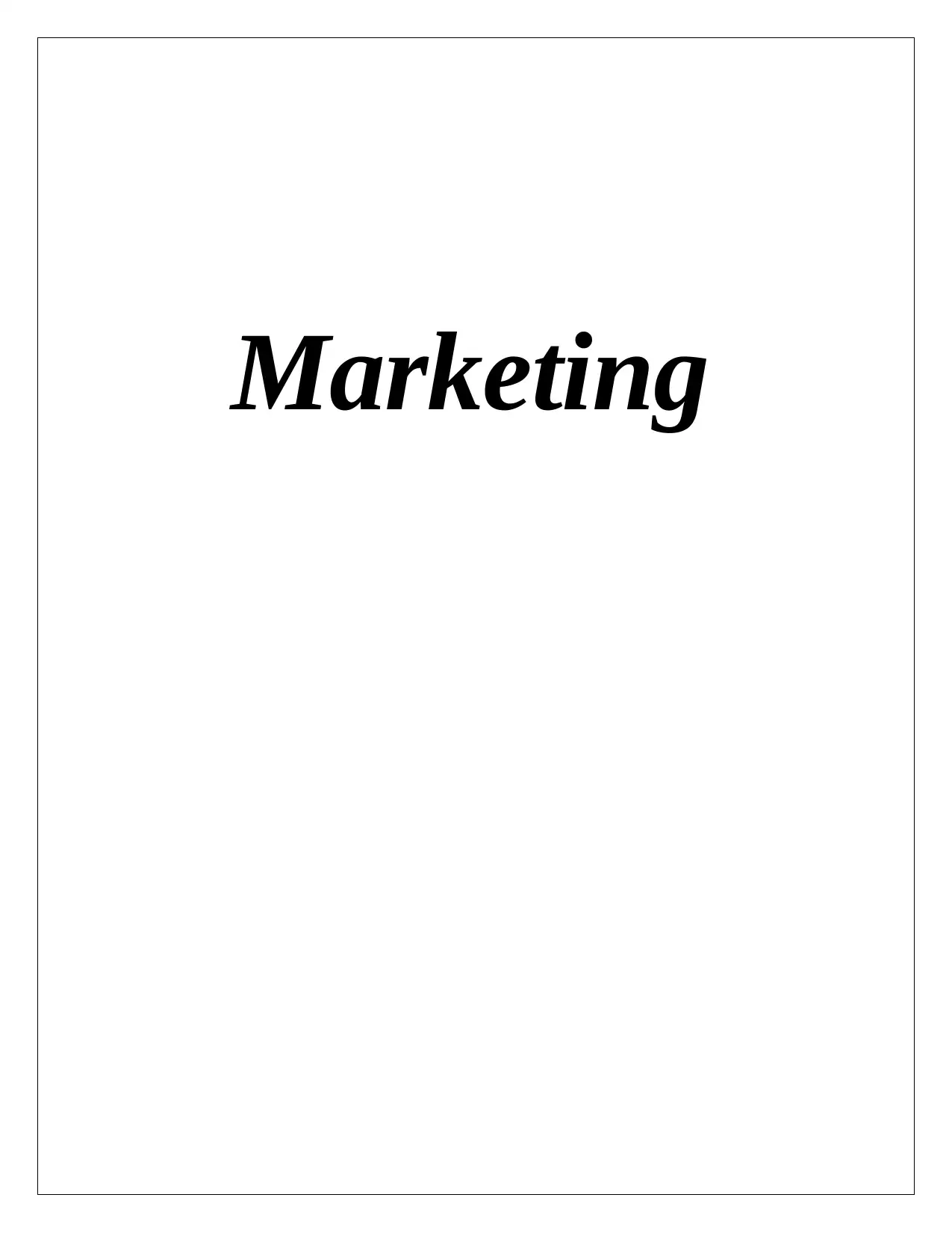
Marketing
Paraphrase This Document
Need a fresh take? Get an instant paraphrase of this document with our AI Paraphraser
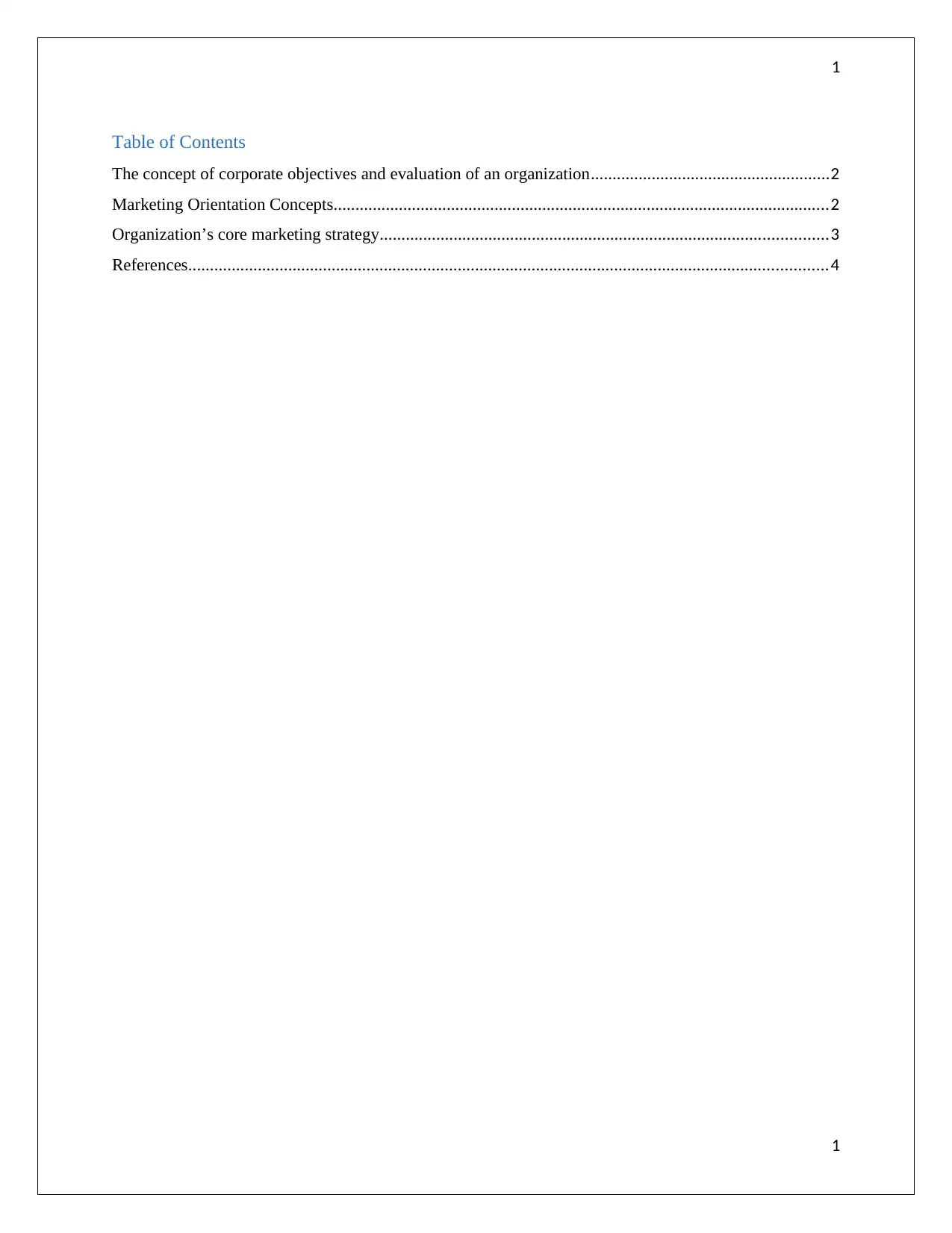
1
Table of Contents
The concept of corporate objectives and evaluation of an organization.......................................................2
Marketing Orientation Concepts..................................................................................................................2
Organization’s core marketing strategy.......................................................................................................3
References...................................................................................................................................................4
1
Table of Contents
The concept of corporate objectives and evaluation of an organization.......................................................2
Marketing Orientation Concepts..................................................................................................................2
Organization’s core marketing strategy.......................................................................................................3
References...................................................................................................................................................4
1
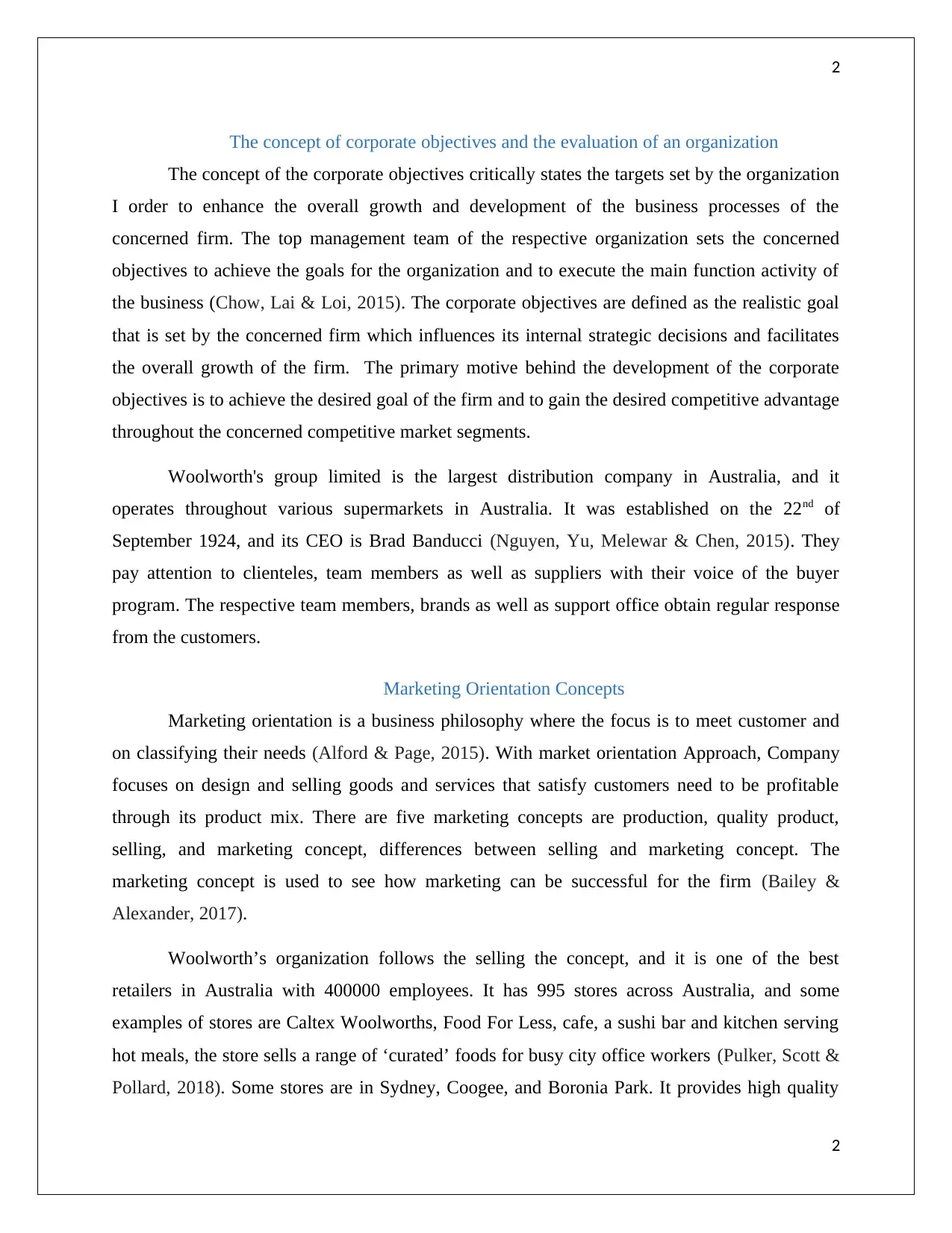
2
The concept of corporate objectives and the evaluation of an organization
The concept of the corporate objectives critically states the targets set by the organization
I order to enhance the overall growth and development of the business processes of the
concerned firm. The top management team of the respective organization sets the concerned
objectives to achieve the goals for the organization and to execute the main function activity of
the business (Chow, Lai & Loi, 2015). The corporate objectives are defined as the realistic goal
that is set by the concerned firm which influences its internal strategic decisions and facilitates
the overall growth of the firm. The primary motive behind the development of the corporate
objectives is to achieve the desired goal of the firm and to gain the desired competitive advantage
throughout the concerned competitive market segments.
Woolworth's group limited is the largest distribution company in Australia, and it
operates throughout various supermarkets in Australia. It was established on the 22nd of
September 1924, and its CEO is Brad Banducci (Nguyen, Yu, Melewar & Chen, 2015). They
pay attention to clienteles, team members as well as suppliers with their voice of the buyer
program. The respective team members, brands as well as support office obtain regular response
from the customers.
Marketing Orientation Concepts
Marketing orientation is a business philosophy where the focus is to meet customer and
on classifying their needs (Alford & Page, 2015). With market orientation Approach, Company
focuses on design and selling goods and services that satisfy customers need to be profitable
through its product mix. There are five marketing concepts are production, quality product,
selling, and marketing concept, differences between selling and marketing concept. The
marketing concept is used to see how marketing can be successful for the firm (Bailey &
Alexander, 2017).
Woolworth’s organization follows the selling the concept, and it is one of the best
retailers in Australia with 400000 employees. It has 995 stores across Australia, and some
examples of stores are Caltex Woolworths, Food For Less, cafe, a sushi bar and kitchen serving
hot meals, the store sells a range of ‘curated’ foods for busy city office workers (Pulker, Scott &
Pollard, 2018). Some stores are in Sydney, Coogee, and Boronia Park. It provides high quality
2
The concept of corporate objectives and the evaluation of an organization
The concept of the corporate objectives critically states the targets set by the organization
I order to enhance the overall growth and development of the business processes of the
concerned firm. The top management team of the respective organization sets the concerned
objectives to achieve the goals for the organization and to execute the main function activity of
the business (Chow, Lai & Loi, 2015). The corporate objectives are defined as the realistic goal
that is set by the concerned firm which influences its internal strategic decisions and facilitates
the overall growth of the firm. The primary motive behind the development of the corporate
objectives is to achieve the desired goal of the firm and to gain the desired competitive advantage
throughout the concerned competitive market segments.
Woolworth's group limited is the largest distribution company in Australia, and it
operates throughout various supermarkets in Australia. It was established on the 22nd of
September 1924, and its CEO is Brad Banducci (Nguyen, Yu, Melewar & Chen, 2015). They
pay attention to clienteles, team members as well as suppliers with their voice of the buyer
program. The respective team members, brands as well as support office obtain regular response
from the customers.
Marketing Orientation Concepts
Marketing orientation is a business philosophy where the focus is to meet customer and
on classifying their needs (Alford & Page, 2015). With market orientation Approach, Company
focuses on design and selling goods and services that satisfy customers need to be profitable
through its product mix. There are five marketing concepts are production, quality product,
selling, and marketing concept, differences between selling and marketing concept. The
marketing concept is used to see how marketing can be successful for the firm (Bailey &
Alexander, 2017).
Woolworth’s organization follows the selling the concept, and it is one of the best
retailers in Australia with 400000 employees. It has 995 stores across Australia, and some
examples of stores are Caltex Woolworths, Food For Less, cafe, a sushi bar and kitchen serving
hot meals, the store sells a range of ‘curated’ foods for busy city office workers (Pulker, Scott &
Pollard, 2018). Some stores are in Sydney, Coogee, and Boronia Park. It provides high quality
2
⊘ This is a preview!⊘
Do you want full access?
Subscribe today to unlock all pages.

Trusted by 1+ million students worldwide
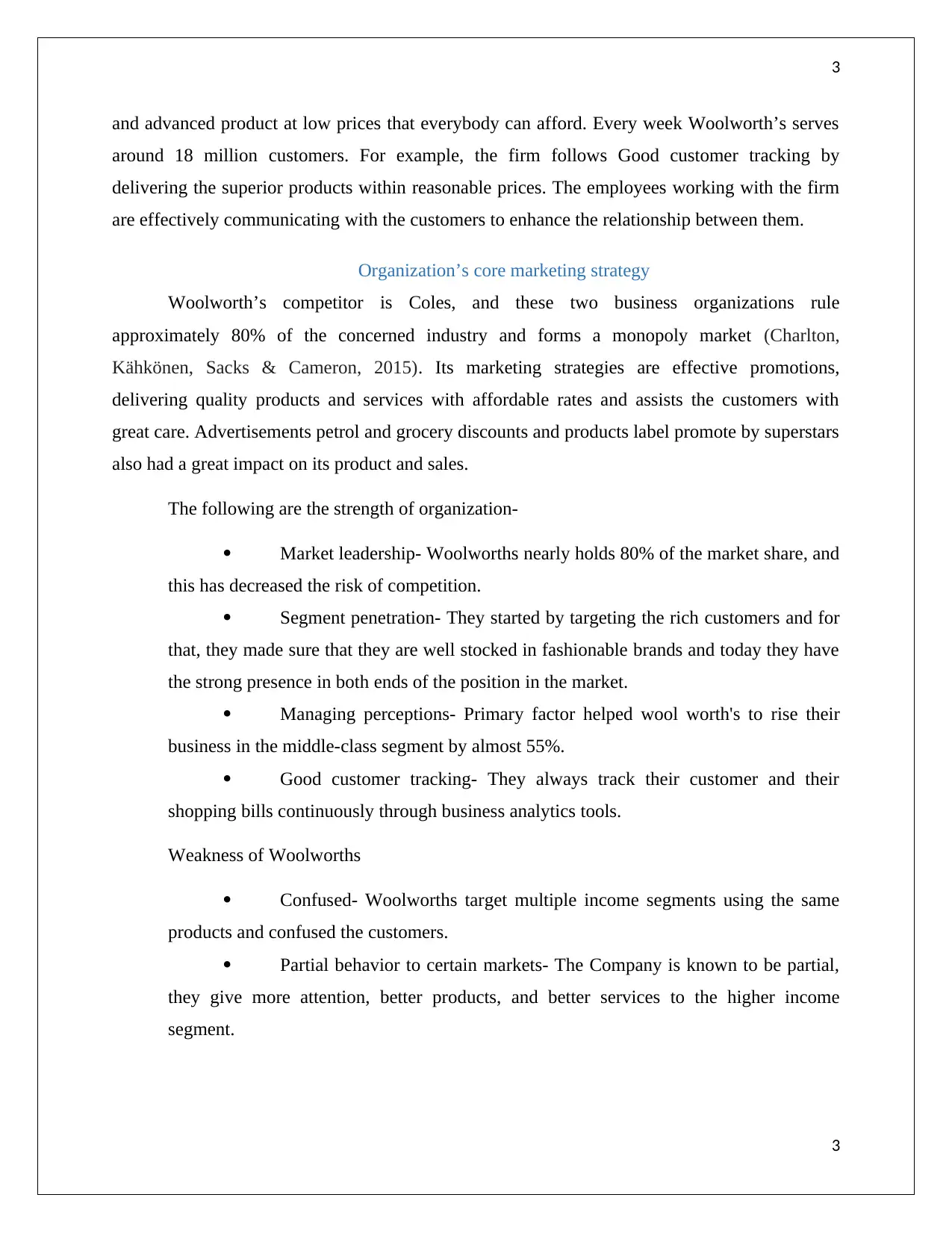
3
and advanced product at low prices that everybody can afford. Every week Woolworth’s serves
around 18 million customers. For example, the firm follows Good customer tracking by
delivering the superior products within reasonable prices. The employees working with the firm
are effectively communicating with the customers to enhance the relationship between them.
Organization’s core marketing strategy
Woolworth’s competitor is Coles, and these two business organizations rule
approximately 80% of the concerned industry and forms a monopoly market (Charlton,
Kähkönen, Sacks & Cameron, 2015). Its marketing strategies are effective promotions,
delivering quality products and services with affordable rates and assists the customers with
great care. Advertisements petrol and grocery discounts and products label promote by superstars
also had a great impact on its product and sales.
The following are the strength of organization-
Market leadership- Woolworths nearly holds 80% of the market share, and
this has decreased the risk of competition.
Segment penetration- They started by targeting the rich customers and for
that, they made sure that they are well stocked in fashionable brands and today they have
the strong presence in both ends of the position in the market.
Managing perceptions- Primary factor helped wool worth's to rise their
business in the middle-class segment by almost 55%.
Good customer tracking- They always track their customer and their
shopping bills continuously through business analytics tools.
Weakness of Woolworths
Confused- Woolworths target multiple income segments using the same
products and confused the customers.
Partial behavior to certain markets- The Company is known to be partial,
they give more attention, better products, and better services to the higher income
segment.
3
and advanced product at low prices that everybody can afford. Every week Woolworth’s serves
around 18 million customers. For example, the firm follows Good customer tracking by
delivering the superior products within reasonable prices. The employees working with the firm
are effectively communicating with the customers to enhance the relationship between them.
Organization’s core marketing strategy
Woolworth’s competitor is Coles, and these two business organizations rule
approximately 80% of the concerned industry and forms a monopoly market (Charlton,
Kähkönen, Sacks & Cameron, 2015). Its marketing strategies are effective promotions,
delivering quality products and services with affordable rates and assists the customers with
great care. Advertisements petrol and grocery discounts and products label promote by superstars
also had a great impact on its product and sales.
The following are the strength of organization-
Market leadership- Woolworths nearly holds 80% of the market share, and
this has decreased the risk of competition.
Segment penetration- They started by targeting the rich customers and for
that, they made sure that they are well stocked in fashionable brands and today they have
the strong presence in both ends of the position in the market.
Managing perceptions- Primary factor helped wool worth's to rise their
business in the middle-class segment by almost 55%.
Good customer tracking- They always track their customer and their
shopping bills continuously through business analytics tools.
Weakness of Woolworths
Confused- Woolworths target multiple income segments using the same
products and confused the customers.
Partial behavior to certain markets- The Company is known to be partial,
they give more attention, better products, and better services to the higher income
segment.
3
Paraphrase This Document
Need a fresh take? Get an instant paraphrase of this document with our AI Paraphraser
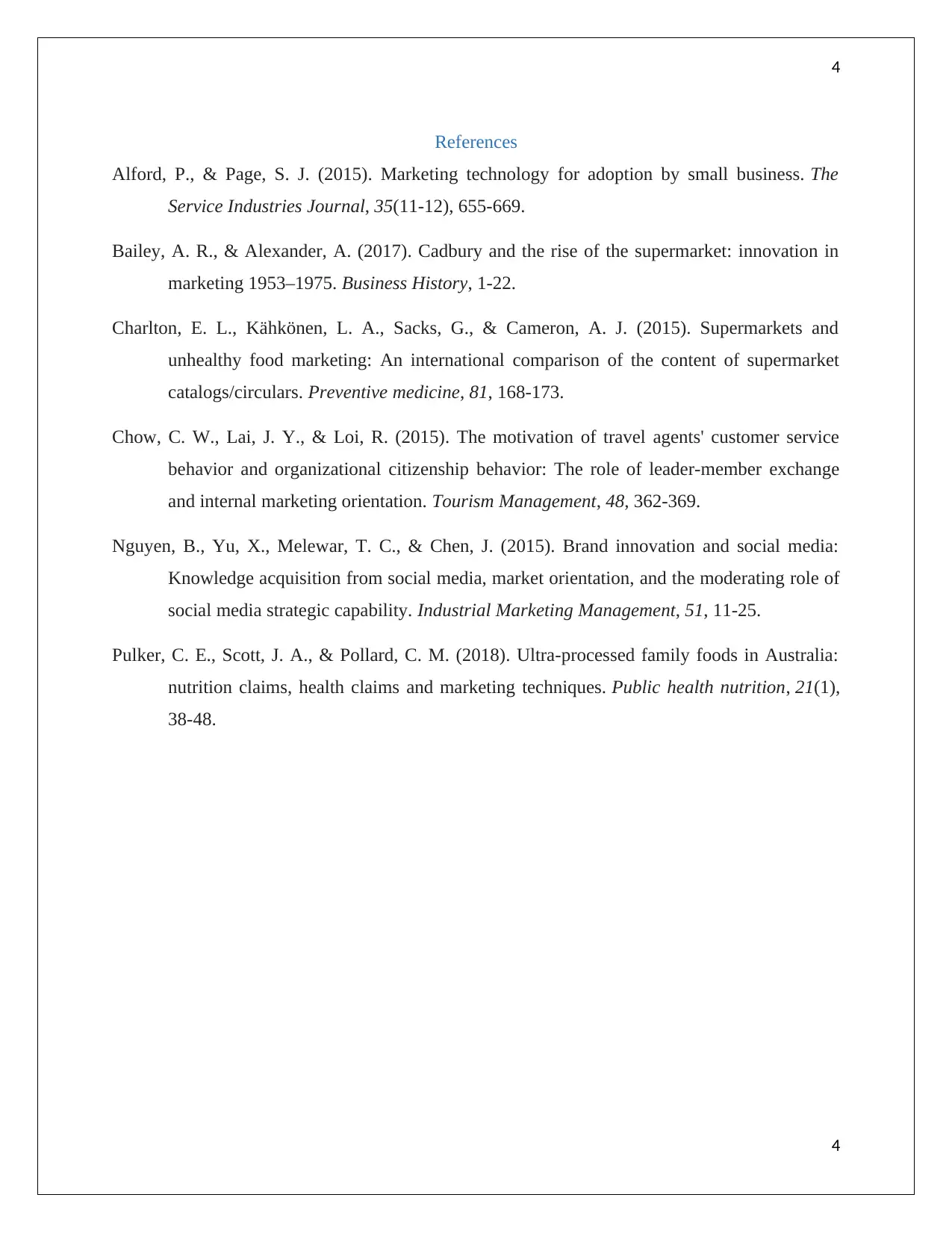
4
References
Alford, P., & Page, S. J. (2015). Marketing technology for adoption by small business. The
Service Industries Journal, 35(11-12), 655-669.
Bailey, A. R., & Alexander, A. (2017). Cadbury and the rise of the supermarket: innovation in
marketing 1953–1975. Business History, 1-22.
Charlton, E. L., Kähkönen, L. A., Sacks, G., & Cameron, A. J. (2015). Supermarkets and
unhealthy food marketing: An international comparison of the content of supermarket
catalogs/circulars. Preventive medicine, 81, 168-173.
Chow, C. W., Lai, J. Y., & Loi, R. (2015). The motivation of travel agents' customer service
behavior and organizational citizenship behavior: The role of leader-member exchange
and internal marketing orientation. Tourism Management, 48, 362-369.
Nguyen, B., Yu, X., Melewar, T. C., & Chen, J. (2015). Brand innovation and social media:
Knowledge acquisition from social media, market orientation, and the moderating role of
social media strategic capability. Industrial Marketing Management, 51, 11-25.
Pulker, C. E., Scott, J. A., & Pollard, C. M. (2018). Ultra-processed family foods in Australia:
nutrition claims, health claims and marketing techniques. Public health nutrition, 21(1),
38-48.
4
References
Alford, P., & Page, S. J. (2015). Marketing technology for adoption by small business. The
Service Industries Journal, 35(11-12), 655-669.
Bailey, A. R., & Alexander, A. (2017). Cadbury and the rise of the supermarket: innovation in
marketing 1953–1975. Business History, 1-22.
Charlton, E. L., Kähkönen, L. A., Sacks, G., & Cameron, A. J. (2015). Supermarkets and
unhealthy food marketing: An international comparison of the content of supermarket
catalogs/circulars. Preventive medicine, 81, 168-173.
Chow, C. W., Lai, J. Y., & Loi, R. (2015). The motivation of travel agents' customer service
behavior and organizational citizenship behavior: The role of leader-member exchange
and internal marketing orientation. Tourism Management, 48, 362-369.
Nguyen, B., Yu, X., Melewar, T. C., & Chen, J. (2015). Brand innovation and social media:
Knowledge acquisition from social media, market orientation, and the moderating role of
social media strategic capability. Industrial Marketing Management, 51, 11-25.
Pulker, C. E., Scott, J. A., & Pollard, C. M. (2018). Ultra-processed family foods in Australia:
nutrition claims, health claims and marketing techniques. Public health nutrition, 21(1),
38-48.
4
1 out of 5
Related Documents
Your All-in-One AI-Powered Toolkit for Academic Success.
+13062052269
info@desklib.com
Available 24*7 on WhatsApp / Email
![[object Object]](/_next/static/media/star-bottom.7253800d.svg)
Unlock your academic potential
Copyright © 2020–2025 A2Z Services. All Rights Reserved. Developed and managed by ZUCOL.





